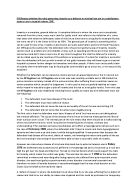The Actus Reus of constructive manslaughter is virtually exactly the same as for murder. This seems absurd as murder is intended however the only requirement is that D to causes the death of another human being.
In Dalby (1982), Waller LJ said, obiter, that ‘where the charge of manslaughter is based on an unlawful and dangerous act, it must be an act directed at the victim and likely to cause immediate injury, however slight.’ This dictum particularly the reference to ‘an act directed at the victim’ is notoriously ambiguous. However it has subsequently been held that Waller LJ was simply confirming that D’s act must cause V’s death. Given that constructive manslaughter requires an unlawful and a dangerous act, it follows that if D omits to act, he cannot be guilty of this form of manslaughter.
The unlawful act will typically be a battery – defined as the intentional or reckless application of unlawful force to another person. In Larkin 1943 a constructive manslaughter conviction based upon the crime of assault was upheld. However if a person is unaware that the act they are committing is unlawful it seems a harsh penalty, however ignorance is no defence and to say that you were unaware of the law is still no excuse to have broken it.
In 1994, the Law commission provisionally recommended the abolition of constructive manslaughter in a consultation paper, Involuntary Manslaughter :
‘It… is inappropriate to convict a defendant for an offence of homicide where the most that can be said is that he or she ought to have realised that there was a risk of some albeit not serious harm to another resulting from his or her commission of an unlawful act.’
In Watts (1998), the COA decided that, whenever the manslaughter by gross negligence is raised then the judge must direct the jury in accordance with the principles established in Adomako. Adomako firmly re-established gross negligence as the correct test.
In 1994 the Law Commission published a consultation paper provisionally recommending the abolition of constructive manslaughter on the basis that it was ‘inappropriate to convict a defendant for an offence of homicide where the most that can some, albeit not serious harm, to another resulting from his or her report which recommended :
- The abolition of involuntary manslaughter altogether
- Its replacement by two new offences of ‘reckless killing’ and ‘killing by gross carelessness.’
The biggest problem identified for maintaining involuntary manslaughter was considered to be the width of situations it can cover, which presents judges with significant problems, particularly when determining the appropriate sentence to be imposed in any given case. The new offences were defined in a draft bill attached to the report as follows.
Reckless killing
A person commits reckless killing if :
- His or her conduct causes death of another
- He or she is aware of a risk that his or her conduct will cause death or serious injury
- It is unreasonable for him or her take that risk having regard to the circumstance as he or she knows or believes them to be.
Killing by gross carelessness
A person commits killing by gross carelessness if:
- His or her conducts causes the death of another
- A risk that his or her conduct will cause death or serious injury would be an obvious to a reasonable person in his or her position
- He or she is capable of appreciating that risk at this material time (but did not in fact do so)
And either
- His or her conduct falls far below what can be reasonably expected in the circumstances
Or
- He or she intends by his or her conduct to cause some injury or is aware of and unreasonably takes the risk that it may do so, and the conduct causing or intended to cause the injury constitutes an offence.
The law commission’s draft bill included at Clause 3 a provision to preserve the rule that persons who failed to act when under a common law or statutory duty to do so would be liable under both new offences. The Law commission did not recommend a new offence to cover the situation where D commits a relatively minor assault and which causes death but where that death was not foreseeable (this would presently fall under constructive manslaughter.) Four years later the Home office published its own document, Reforming the Law on Involuntary Manslaughter : The Government’s proposals (2000). This was broadly in agreement with the Law Commission’s proposals, although the Home Office described the idea that an assault causing death would no longer be classed as manslaughter as ‘unacceptable.’ This seems harsh but as the Government stated ‘anyone who embarks on a course of illegal violence has to accept the consequences of his act, even if the final consequences are unforeseeable.’ The terms of the new offence in the 2000 document are that :
- A person by his or her conduct causes the death of another.
- He or she intended to or was reckless as to whether some injury was caused.
- The conduct causing or intended to cause, the injury constitutes an offence.
These conditions are concise and the law governing involuntary manslaughter is in a reasonable state, with there being clear boundaries where there is liability as in breaches of duty or gross negligence and where there is no relationship at all as concluded in R V Khan and Khan. There are clear and logical tests, such as the Church Test (1965) where it must be recognised that the danger of the action would have been recognised by a ‘sober and reasonable person’ that help judges reach satisfactory conclusions and direct juries correctly. The Government has stated that it is rational for a person ‘to accept the consequences of his act, even if the final consequences are unforeseeable.’ This is satisfactory as it would be ridiculous to allow people to escape the sentence of manslaughter just because they did not foresee the risk of death, as stated before ignorance is no defence. Thus the law governing involuntary manslaughter, in my critical opinion is in a satisfactory state.








